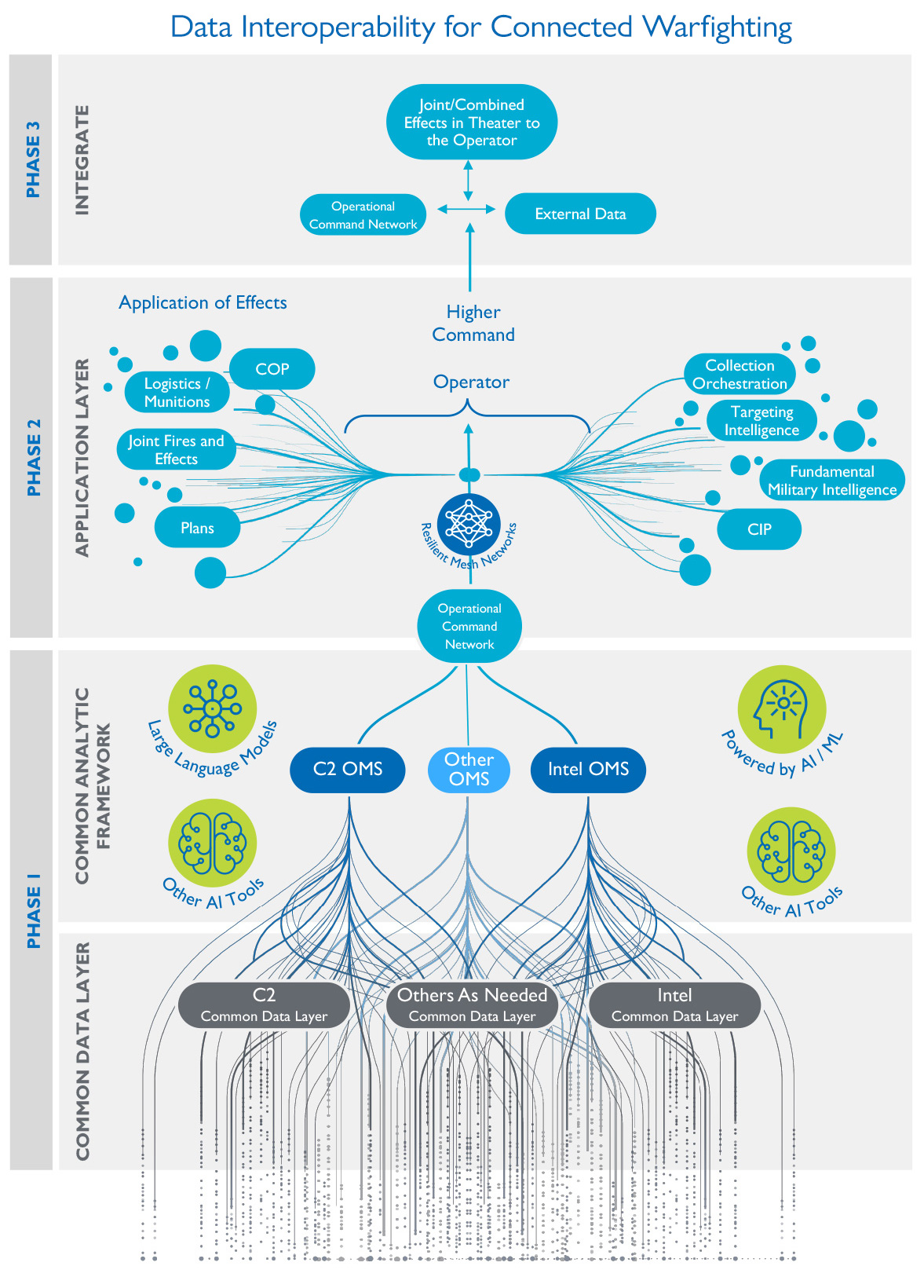 02-03-2025
02-03-2025
Key Takeaways:
- Creating a common data layer is the best solution for the U.S. Air Force to support data interoperability and accelerate decision-making from the enterprise level to the edge.
- AI integration enhances data interoperability, reduces operators' cognitive load and improves decision-making through predictive analytics and actionable intelligence.
- Integrating external data sources with the common data layer expands situational awareness and enhances the value of shared information in coordinated operations.
LISTEN TO THIS FEATURE:
Fifth- and sixth-generation warfare challenges traditional combat and military strategy. In this era, the U.S. Air Force will never fight alone. The multi-domain nature of modern warfare demands coordinated actions across the armed services and with foreign allies across air, land, sea, cyber and space operations. The more vital joint and combined operations become, the more critical it is for the Air Force to have seamless communications and data interoperability.
However, current Air Force communication networks and mission command-and-control systems were not designed, developed or deployed to enable seamless data sharing across different Air Force aircraft platforms or to support a common operating picture for joint or combined operations. This creates stovepipe challenges, which exist across all the services and at the joint level.
While interconnected warfighting requires a shift from service-specific mindsets and operational norms, it also requires a shift from a network-centric to data-centric paradigm. The right investments in modern technologies can enable this shift. The result is an adaptive ecosystem where partners can share data in real time to support coordinated battle decisions.
Create a common data layer: Connect disparate data with access controls
Creating an enterprise data layer is the best solution for the Air Force to enable this data-centric paradigm and accelerate decision-making from the enterprise level to the edge. In simple terms, a common data layer allows the right data to get to the right decision-maker at the right time—whether they are piloting an F-35A, coordinating a multilateral military exercise or operating an uncrewed vehicle from a remote location.
A common data layer is a breakthrough in the Air Force’s ability to continuously transform data into actionable intelligence for proactive and timely decisions in the operating environment.
There are “zero-trust for data” platforms that create a common data layer and are well suited for the DOD environment. With fine-grained, attribute-based access control, these platforms support the integration and analysis of data from federated data sources of varying classification levels. Combined with best-in-class data management services for rapid data transport, ingestion and indexing, these platforms support end-to-end, multi-level security. Data tagging capability safeguards clearance levels, unlocking data that was previously fully restricted due to classification for sharing among authorized personnel. And of particular importance, zero-trust solutions enable a leap ahead in cybersecurity over current or legacy network-centric architectures.
With the right zero-trust for data platform, the Air Force can quickly integrate millions of records per second from structured, unstructured and real-time streaming data sources to prepare data for low-latency ingestion into decision-support applications and analytics. These platforms manage the synchronization and prioritization of data to target information sharing with surgical precision. They enable the resilient data and networking operations required for ubiquitous access to targetable data, even in DDIL (denied, disrupted, intermittent and low-bandwidth) environments.
A common data layer can evolve and adapt. Sustained effectiveness requires ongoing monitoring and optimization, security enhancements and continuous development to ensure the common data layer is optimized for reliability, responsiveness and scalability, all of which are necessary to adapt to shifting operational requirements. Given the speed of technology enhancement, there will always be opportunities to integrate new technologies in areas such as artificial intelligence, targeting, intelligence and battlespace awareness to further improve capability.
Joint Fires Network:
Common Data Layer in Action
SAIC is a key integrator for the Joint Fires Network (JFN) common data layer. The JFN is a large-scale prototyping and integration effort that addresses immediate warfighter needs in the U.S. Indo-Pacific Command (USINDOPACOM). It also serves as a pathfinder for the DOD’s broader combined joint all-domain command and control (CJADC2) effort to speed dynamic decision-making by digitally connecting its armed services, combatant commands and partners.
JFN common data layer integrates feeds of blue- and red-force information from disparate data platforms, weapon systems and applications in real time to display actionable threat and fires information to joint and combined forces. It combines a suite of command-and-control, battle management and sense-making applications organized within an application layer.
These applications securely access tagged, labeled and structured data via application programming interfaces (APIs) from the JFN common data layer, which manages data ingestion from authoritative data repositories and data transformation as well as analytic tasks like correlation, deduplication and fusion. This cloud-based, agnostic architecture enables rapid integration of new technologies within a multi-vendor ecosystem through plug-and-play API integration. It supports modern applications and rapid system integration for more complex or legacy systems.
Empower the edge with actionable intelligence: Integrate AI into C5ISR
The integration of AI into command, control, computers, communications, cyber, intelligence, surveillance and reconnaissance (C5ISR) is rapidly transforming the battlefield. In fact, AI makes the common data layer an even more powerful enabler of data interoperability. Moreover, for many command-and-control and intelligence challenges, AI cannot be fully effective when the data is trapped in legacy stovepipes. This is because a single AI application only has access to part of the data needed. The common data layer breaks the legacy stovepipes and makes all the relevant data accessible to the AI application—enabling the joint force to get the best decision support from AI. Commands can increase or connect multiple data layers, deepen analytics capabilities and scale data analysis and interoperability with speed and precision.
AI orchestration tools can be added onto the common data layer to support such capability. Using cutting-edge algorithms and a scalable architecture, these tools sift through vast amounts of data, prioritize information and present actionable intelligence. This is key in Air Force C5ISR environments where the velocity, volume and variety of data exceed human cognitive limits. By effectively managing sensor inputs, intelligence feeds and various communication streams, AI orchestrators direct targeted and timely information to commanders, operators and warfighters.
AI-orchestration tools enable various components of C5ISR to work in concert, reducing the cognitive load on Air Force operators and increasing the speed of command and control.
The best of these orchestration tools are highly adaptable and have robust integration capabilities. In the complex landscape of C5ISR, where systems and platforms are often a mix of legacy and modern technologies, AI orchestrators can be a unifying force. They seamlessly integrate with various data sources and platforms, using AI to harmonize the information collected. This data harmonization improves interoperability and provides the common operating picture that is essential for coordinated action in fifth- and sixth-generation operational landscapes.
By leveraging these tools’ machine learning and predictive analytics capabilities, operators can forecast potential threats and suggest courses of action to mitigate countermeasures. AI algorithms analyze historical and real-time data to identify patterns, anomalies and correlations that might signify emerging threats or opportunities. With this predictive threat analysis, C5ISR operators can share anticipatory intelligence grounded in pre-emptive actions with joint and coalition forces. This anticipatory intelligence is essential for maintaining a tactical edge in complex and dynamic operational theaters.
Joint Fires Network:
Network Integration in Action
SAIC engineers worked in real time to integrate JFN, led by the Office of the Under Secretary of Defense for Research and Engineering, with a decentralized networking capability and a target management solution which included programmatic support from the Chief Digital and Artificial Intelligence Office team and the PACFLT Offensive Maritime Information Operations Center. This integration made it possible to publish a previously unavailable tactical ISR picture directly into JFN common data layer. It was accessible to warfighters, decision-makers and other software applications in the JFN ecosystem. This integration was done in hours, not days, due to the flexibility of the common data layer. It also passed SECRET/REL data from system high to low, demonstrating its ability to enable decision-advantage opportunities for operational and tactical command-and-control echelons, both joint and coalition.

Click image to enlarge
The most useful orchestration tools for the Air Force support both “high-code, high-customization” and “low-code, no-code” capabilities that allow non-technical users to do meaningful work in secure environments. This ability to meet users where they are in terms of capability is very valuable in operational environments where resources and specialized expertise may be limited.
Multiply impact with network integration: Connect the common data layer with external data
Enriching the common data layer with external data can significantly expand situational awareness for Air Force commands and enrich the value of information shared in coordinated operations. Strategically valuable external data sources include national intelligence data, DOD sensor data, coalition partner data and open-source data.
To facilitate this integration, the underlying architecture must allow for the seamless integration of multiple and adapting battlespace networks to “feed” the common data layer. Once integrated, the networks must be resilient and have the speed, functionality and interoperability to continually push data to the common data layer. When data is government-owned, and the government has all of the data rights, the Air Force can access and utilize any data via the common data layer. Further, this data can be distributed to any authorized user and vendor through customizable applications that are enabled via APIs.
Specific, secure and shared: Data interoperability for modern warfare
Stovepipe communication networks and mission command systems are liabilities for the Air Force in the modern era. By developing a common data layer, integrating AI into C5ISR and connecting the common data layer with external data, Air Force commands can create support data interoperability in new ways, enabling the modern, extensible and agile dynamic targeting capability that is essential for making battlefield decisions with confidence.
Learn more
SAIC has extensive experience helping the DOD achieve data interoperability to accelerate battlespace effectiveness and support operations in global and digitally integrated warfighting environments. To learn more about how to facilitate secure and efficient data sharing among combatant partners, contact Jon Rhone, SAIC's C5ISR strategy lead.
Learn more about All-Domain Warfighting


